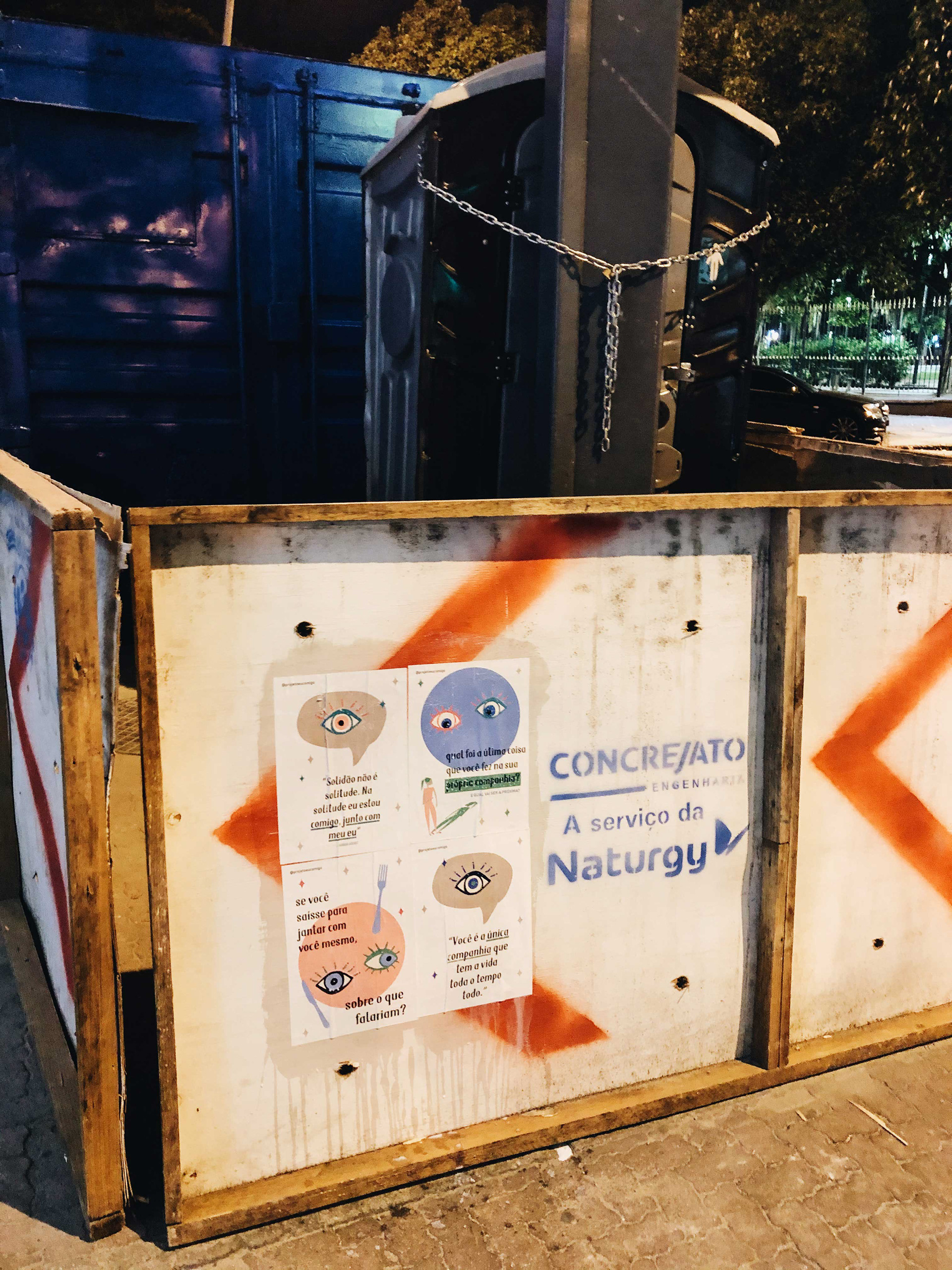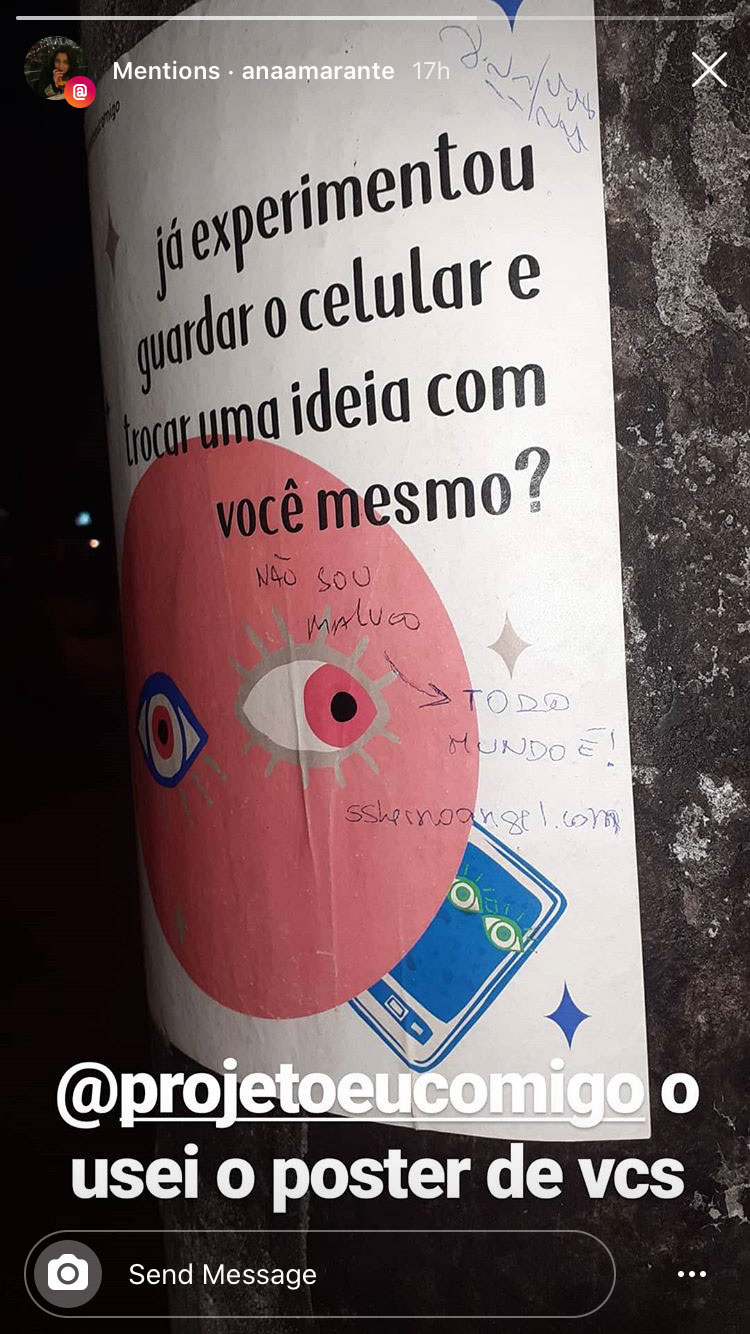The "Eu Comigo" (me with myself) project is a system of analogical inputs into people's daily moments, in order to reach the receiver constantly, so that their own reflection on the topic grows gradually. These inputs consist of "fast messages", with an instigating and personal character; a stimulus to reach the reader in a moment of inertia in his everyday life, and therefore create a suspension of time: for a brief moment he connects directly with that message. They were allocated in places that provide such “stopping moments” (a pause/breathing during the day), such as public transportation, pedestrian crossings, bus stops, bars, bathroom stalls, among others.
This project holds characteristics similar to not-institutionalized guerrilla marketing, and aims to have a personal tone of voice - in addition to being slightly provocative and informal. The recipient has to feel that another person left that message there for him. Along with the analog pieces (which consist of: wheatpastes, cards, stickers and beer crackers), the project also has a digital support: an instagram account (@projetoeucomigo) to help disseminate the project.
This project presents and addresses the concept and habit of solitude at an anthropological level. From theory research, interviews, studies of the nuances of solitude and how people understand and/or develop it, the project seeks to achieve, through the solution found, the destigmatisation of being alone within the society, therefore naturalising solitude and disseminating this concept.
“Solitude means full contact with oneself. This means that there is no need to always be with other people and there is no loneliness for that. This person is fine with yourself full time, but lives very well with others. Note that there is a direct contact with yourself, being able to spend several days in a place alone and feeling full; but there is also a fullness in being with someone.” (Maura de ALBANESI)




motivation
The project originates from a personal motivation to challenge the taboo of solitude in society and disseminate this concept. I have always had the habit and ease of doing the most diverse things on my own, like going to the cinema, restaurant or a concert. Being in constant direct contact with oneself has always seemed essential to our experience as humans. On the other hand, I would frequently notice a strangeness of people around me on such occasions. A while ago I had the opportunity to fulfill a dream of mine: do a trip on my own, and when I shared my plans with friends, the already familiar strangeness became even more evident. Questions like "Was there no one to go with you?" were widely shared, and at that moment it became more clear than ever that I needed to talk about solitude.
As a consequence of the personal relevance of this theme, I started to take notice of these situations in the "bigger picture", trying to understand how society behaves when the matter is being alone. Understanding the complexity of the topic and the need for it to be addressed, I identified a project opportunity there, taking into account the observation that being alone is constantly misinterpreted as loneliness.
I would also like to add that this project is directly connected to the portuguese language. In english, you have the words loneliness and solitude, whereas in portuguese, the two are very similar (solidão x solitude), which often leads to misinterpretations. There are, also, the words lonely x by myself, which hold different meanings - and in portuguese there is no habit of saying "by myself, but would be "comigo mesmo", and that was the source of inspiration for the project name. Language is a very important matter on this subject, and I quote Hannah Arednt: “Loneliness is not solitude. [...] In solitude [...] I am “by myself”, together with myself, and therefore two-in-one, whereas in loneliness I am actually one, deserted by all others.”












O EU COMIGO foi meu projeto de conclusão da faculdade de design. Ele passou por um processo de pesquisa e conceituação muito vasto e rico. Por isso, decidi disponibilizar o relatório feito, com toda a jornada percorrida, desde a pesquisa teórica até o resultado final. Clique aqui.